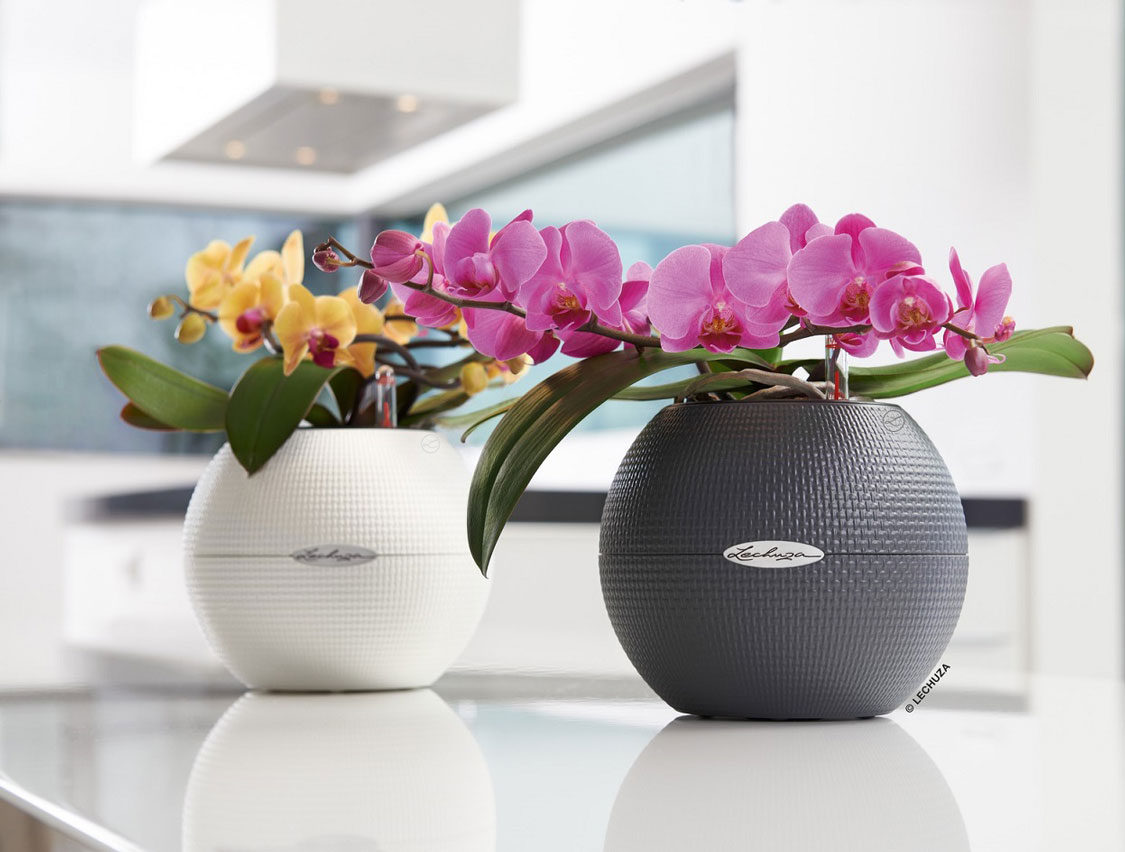A LECHUZA expert has these professional tips on caring for orchids, and if you need to repot, simply use an appropriate LECHUZA planter
RELATED TO ORCHID CARE: How to repot orchids
THE BASICS
Most orchids available in shops are called epiphytes. In their natural habitat, you’d typically find them on trees in the rain forest. This includes the genera Phalaenopsis, Cattleya, Oncidium, Dendrobium, and Miltonia. It’s easy to decide what an orchid needs by considering its natural environment. They don’t like soil, stagnant water and or too much fertiliser. This is similar to the conditions they would find on a tree.
WHAT THEY LIKE
Orchids like light
Not all of them can take direct sunlight though. A windowsill facing east or west is ideal.
Too much water is dangerous
Orchids are prone to root rot. Coming from the rainforest, most orchids love high humidity, but cannot bear stagnant water near their roots.
Fertilise correctly
Because of the long-lasting fertiliser contained in LECHUZA-PON, you don’t need to fertilise your plant for up to one year. After that, a standard fertiliser can be added to the water.
Loss of blossoms
It is completely normal for orchids to drop their petals now and then. This has nothing to do with a lack of ability to care for your plants. When the orchid has lost its blossom on a stipe (stem) and no more blooms are on their way, cut the stipe back, before it starts to get yellow. You have two possibilities:
1 The fast way: Shorten about 1cm over the second or third latent bud – this will cause a new sprout to grow quickly.
2 The gardener’s way: Give your plant time to recover by cutting the sprout 1cm above the first latent bud – the latent bud will evolve into a new sprout. If you use the second method, it will take longer for a new blossom to grow (up to half a year), but your orchid will thank you with brighter colours and a stronger bloom.
YOU’LL ALSO LOVE: Growing orchids
EXPERT ORCHID CARE TIPS
LECHUZA is a system that simplifies watering so you can water less.
How LECHUZA works
Pour the water directly into the water supply shaft. If there is no shaft available, pour carefully over the PON. Fill the water reservoir half way or completely, depending on the size of your orchid. The water from the reservoir will be transported to the roots through the wick. When the water is finished, maintain a dry phase for up to a week. The PON saves lots of water and gives it to the plant during this time. Should the leaves of the orchid become droopy in the meantime, immediately fill the water reservoir.
Water
Less is more. With the support of the LECHUZA sub-irrigation-system the roots supply themselves without standing in water. Our expert suggests misting the leaves. This imitates their natural habitat and creates a comfortable humidity level around the plant. Orchids prefer lime-free water (e.g. rain water).
YOU’LL ALSO LIKE: Harvest rain water: A water-wise guide
Location
If you’d like to place your orchid in direct sunlight, acclimatise it slowly. Most orchids are raised in greenhouses and hardly exposed to any sunlight, which means that they have to become accustomed to direct sunlight slowly in order to avoid burns. Place your orchid in a sunny place only after it has spent some time in half shade – to avoid the risk of damage.
Fertiliser
Orchids need nutrients in order to grow. As they don’t need much, they are quickly over-fertilised. The LECHUZA fertiliser only gives nutrients as they are needed. It makes sure that you don’t over-fertilise and burn the leaves and roots of your orchid.
STEP BY STEP: ORCHID PLANTING INSTRUCTIONS FROM LECHUZA
- Our table planters are perfect for young orchids. Find the LECHUZA-PON substrate in a bag inside the planter liner. Fill the planter liner with PON, but leave room for the root ball.
- Free the root ball carefully and completely from any wood or bark. Use the opportunity to cut off old/rotten portions of the roots.
- Place your plant with the root ball on the substrate layer. Fill the planter liner completely with LECHUZA-PON substrate. If possible, also put the air roots inside the planter.
- Knocking lightly against the planter ensures that the roots are surrounded by the granulate. Gently firm it down with your fingers, so that the orchid has a stable foundation within the planter.
REPOTTING
When repotting, free the root ball completely from pieces of wood and bark, so that the roots can breathe freely in the substrate. LECHUZA-PON is made from pumice, zeolites, lava, and a fertiliser and ensures optimal air circulation around the roots and stores water and nutrients.

